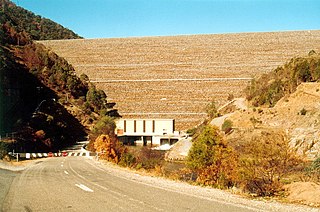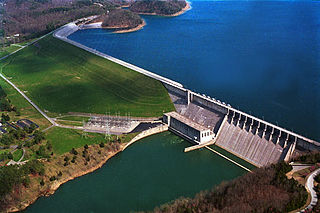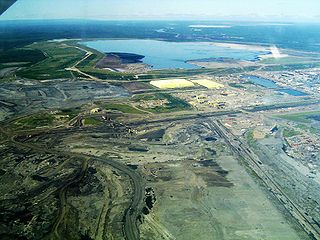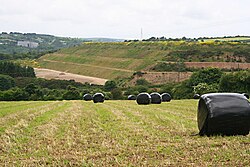
Dartmouth Dam is a large rock-fill embankment dam with an uncontrolled chute spillway across the Mitta Mitta, Gibbo and Dart rivers, the Morass Creek and a number of small tributaries. The dam is located near Mount Bogong in the north-east of the Australian state of Victoria. The dam's purpose includes irrigation, the generation of hydro-electric power, water supply and conservation. The impounded reservoir is called Dartmouth Reservoir, sometimes called Lake Dartmouth. The Dartmouth Power Station, a hydro-electric power station that generates power to the national grid, is located near the dam wall.

A dam is a barrier that stops or restricts the flow of surface water or underground streams. Reservoirs created by dams not only suppress floods but also provide water for activities such as irrigation, human consumption, industrial use, aquaculture, and navigability. Hydropower is often used in conjunction with dams to generate electricity. A dam can also be used to collect or store water which can be evenly distributed between locations. Dams generally serve the primary purpose of retaining water, while other structures such as floodgates or levees are used to manage or prevent water flow into specific land regions.

Open-pit mining, also known as open-cast or open-cut mining and in larger contexts mega-mining, is a surface mining technique that extracts rock or minerals from the earth using a pit, sometimes known as a borrow pit.

In mining, tailings or tails are the materials left over after the process of separating the valuable fraction from the uneconomic fraction (gangue) of an ore. Tailings are different from overburden, which is the waste rock or other material that overlies an ore or mineral body and is displaced during mining without being processed.

The Wolf Creek Dam is a multi-purpose dam on the Cumberland River in the western part of Russell County, Kentucky, United States. The dam serves at once four distinct purposes: it generates hydroelectricity; it regulates and limits flooding; it releases stored water to permit year-round navigation on the lower Cumberland River; and it creates Lake Cumberland for recreation, the largest man made lake by volume East of the Mississippi river. The Lake has become a popular tourist attraction.U.S. Route 127 is built on top of the dam.
Internal erosion is the formation of voids within a soil caused by the removal of material by seepage. It is the second most common cause of failure in levees and one of the leading causes of failures in earth dams, responsible for about half of embankment dam failures.

An embankment dam is a large artificial dam. It is typically created by the placement and compaction of a complex semi-plastic mound of various compositions of soil or rock. It has a semi-pervious waterproof natural covering for its surface and a dense, impervious core. This makes the dam impervious to surface or seepage erosion. Such a dam is composed of fragmented independent material particles. The friction and interaction of particles binds the particles together into a stable mass rather than by the use of a cementing substance.

The Syncrude Tailings Dam, impounding the Mildred Lake Settling Basin (MLSB), is an embankment dam that is, by volume of construction material, the largest earth structure in the world in 2001. It is located 40 km (25 mi) north of Fort McMurray, Alberta, Canada, at the northern end of the Mildred Lake lease area owned by Syncrude Canada Ltd. The dam and the tailings artificial lake within it are constructed and maintained as part of ongoing operations by Syncrude in extracting oil from the Athabasca oil sands. Other tailings dams constructed and operated in the same area by Syncrude include the Southwest Sand Storage (SWSS), which is the third largest dam in the world by volume of construction material after the Tarbela Dam.

Mohale Dam is a concrete faced rock-fill dam in Lesotho. It is the second dam, under Phase 1B of the series of dams of the proposed Lesotho Highlands Water Project (LHWP), which will eventually include five large dams in remote rural areas of Lesotho and South Africa. The project has been built at a cost of US$1.5 billion.

The Merriespruit tailings dam disaster occurred on the night of 22 February 1994 when a tailings dam failed and flooded the suburb of Merriespruit, Virginia, Free State, South Africa. Seventeen people were killed as a result.

The Church Rock uranium mill spill occurred in the U.S. state of New Mexico on July 16, 1979, when United Nuclear Corporation's tailings disposal pond at its uranium mill in Church Rock breached its dam. The accident remains the largest release of radioactive material in U.S. history, having released more radioactivity than the Three Mile Island accident four months earlier.

An ash pond, also called a coal ash basin or surface impoundment, is an engineered structure used at coal-fired power stations for the disposal of two types of coal combustion products: bottom ash and fly ash. The pond is used as a landfill to prevent the release of ash into the atmosphere. Although the use of ash ponds in combination with air pollution controls decreases the amount of airborne pollutants, the structures pose serious health risks for the surrounding environment.
RAVEN (Respecting Aboriginal Values and Environmental Needs) is a charitable organization that provides financial resources to assist Aboriginal nations within Canada in lawfully forcing industrial development to be reconciled with their traditional ways of life, and in a manner that addresses climate change and other ecological sustainability challenges.

Sadd el-Kafara was a masonry embankment dam on Wadi al-Garawi 10 km southeast of Helwan in Cairo, Egypt. The dam was built in the first half of the third millennium BC by the ancient Egyptians for flood control and is the oldest dam of such size in the world. Never completed, the dam was under construction for 10–12 years before being destroyed by a flood. It was rediscovered by Georg Schweinfurth in 1885.

The Fujinuma Dam, was an earth-fill embankment dam in Sukagawa City, Fukushima Prefecture, Japan. It was established on the Ebana River, a tributary of the Abukuma River, 16 km (10 mi) west of the city office of Sukagawa City. Construction on the dam commenced in 1937 and it was completed in 1949 after construction was halted due to World War II. The dam's primary purpose was irrigation. It failed on 11 March 2011 after the 2011 Tōhoku earthquake.

Oil sands tailings ponds are engineered dam and dyke systems used to capture oil sand tailings. Oil sand tailings contain a mixture of salts, suspended solids and other dissolvable chemical compounds such as acids, benzene, hydrocarbons residual bitumen, fine silts and water. Large volumes of tailings are a byproduct of bitumen extraction from the oil sands and managing these tailings is one of the most difficult environmental challenges facing the oil sands industry. An October 2021 Alberta Energy Regulator (AER) report said that in 2020 the tailings ponds increased by another 90 million cubic meters and contained 1.36 billion cubic metres of fluids.

Baogang Tailings Dam, also known as the Baotou Tailings Dam or Weikuang Dam, is a tailings dam in Inner Mongolia, China, on the outer ring of the city of Baotou, about 20 kilometres from the city centre. The dam is filled with tailings and waste slurry from nearby rare earth mineral refinery plants. Accounts of the tailings dam appeared in western media outlets after a visit in 2015 by British writers Tim Maughan, Liam Young and Kate Davies from Unknown Fields, a "nomadic design studio" from London. Footage posted on YouTube by Maughan appears to show him collecting samples from the floor of the dam. Maughan's account contrasts with the Chinese media's own reporting of the rare earth industry in the area. In 2016, Chinese authorities identified contamination of farmlands surrounding the dam.

The structural failure of tailings dams and the ensuing release of toxic metals in the environment is a great concern. The standard of public reporting on tailings dam incidents is poor. A large number remain completely unreported, or lack basic facts when reported. There is no comprehensive database for historic failures. According to mining engineer David M Chambers of the Center for Science in Public Participation, 10,000 years is "a conservative estimate" of how long most tailings dams will need to maintain structural integrity.
The 1965 Valparaíso earthquake struck near La Ligua in Valparaíso Region, Chile, about 140 km (87 mi) from the capital Santiago on Sunday, March 28 at 12:33 local time. The moment magnitude (Mw ) 7.4–7.6 earthquake killed 400–500 people and inflicted US$1 billion in damage. Many deaths were from El Cobre, a mining location that was wiped out after a series of dam failures caused by the earthquake spilled mineral waste onto the area, burying hundreds of residents. The shock was felt throughout the country and along the Atlantic coast of Argentina.



















